#Sign India 2022
Explore tagged Tumblr posts
Text
Heylo my maggotsies... I'm sorry to do this but I have a thing that I really, really need to do (thank you Ash for helping me realise that) but I'm terrified to. so well. I'm going to make one of the posts (Neil reblogged me a couple of days ago so I feel pretty safe making one now since he only lurks by once in two weeks so this is as good a time as it gets to make a post and not expect many notes, yes I'm an overthinker and I'm actually scared of this getting notes).
Sigh. Here goes.
...I'm scared of even typing it.
Nope okay I can do this let's go.
If this post gets 1k notes, I'll look up jobs in design and film making that don't need a college degree.
2k notes, I'll sign up for an Alliance Francaise course so I can have another language on my CV, and I'll find a course that teaches me how to use design software.
5k, I'll look up distance learning alternatives, because just talking about physical college yesterday made me spend the whole morning and afternoon today in and out of nightmares screaming. Fuck.
10k, I'll tell my mum that I can't do the offline college. She's been talking to me about it, but I've been dodging because I'm not well-off and I really need to be earning and idk how to do that without college and I feel so guilty.
15k, I'll officially back out from the college (does that count as dropping out, if it hasn't begun? maybe half. i am a college and a half dropout, my 11th grade self would hate me and my 10th grade self would refuse to believe it).
I don't know what I'll do then. I don't know how to live as trans here in India, I don't know how to earn enough to be able to help my family, I don't know what I'm good at and I'm so fucking terrified. But. I spoke to @random-doctor-on-the-internet last night (I love you Ash you're such a fucking amazing human) and they made me realise that well maybe landing in a hospital with steroids to relieve an allergy attack because of exam stress isn't normal and so.
Well. Here I am. I know I can't do it, but I'm scared to risk everything, it's just not something people do here, dropping out. But also (TW s**cide statistics mentioned below the cut)... And so I've just. Got to do it, got to save myself and say no to college (cue say no to school, kids joke). Somehow be brave enough. And yeah.
To quote a financial express article: "In an alarming situation, a total of 7,62,648 suicides were reported in India between 2018 to 2022, Of this student suicides account for 7.6% at 59,239". Maybe if more people did say fuck you to the system here, that wouldn't be the case. That number could have been 59,240 (aside from everyone who wasn't counted and hushed up), that could have been me, and I don't want to put myself in that situation again. You know? Yeah.
9K notes
·
View notes
Text
The World's Forests Are Doing Much Better Than We Think

You might be surprised to discover... that many of the world’s woodlands are in a surprisingly good condition. The destruction of tropical forests gets so much (justified) attention that we’re at risk of missing how much progress we’re making in cooler climates.
That’s a mistake. The slow recovery of temperate and polar forests won’t be enough to offset global warming, without radical reductions in carbon emissions. Even so, it’s evidence that we’re capable of reversing the damage from the oldest form of human-induced climate change — and can do the same again.
Take England. Forest coverage now is greater than at any time since the Black Death nearly 700 years ago, with some 1.33 million hectares of the country covered in woodlands. The UK as a whole has nearly three times as much forest as it did at the start of the 20th century.
That’s not by a long way the most impressive performance. China’s forests have increased by about 607,000 square kilometers since 1992, a region the size of Ukraine. The European Union has added an area equivalent to Cambodia to its woodlands, while the US and India have together planted forests that would cover Bangladesh in an unbroken canopy of leaves.
Logging in the tropics means that the world as a whole is still losing trees. Brazil alone removed enough woodland since 1992 to counteract all the growth in China, the EU and US put together. Even so, the planet’s forests as a whole may no longer be contributing to the warming of the planet. On net, they probably sucked about 200 million metric tons of carbon dioxide from the atmosphere each year between 2011 and 2020, according to a 2021 study. The CO2 taken up by trees narrowly exceeded the amount released by deforestation. That’s a drop in the ocean next to the 53.8 billion tons of greenhouse gases emitted in 2022 — but it’s a sign that not every climate indicator is pointing toward doom...
More than a quarter of Japan is covered with planted forests that in many cases are so old they’re barely recognized as such. Forest cover reached its lowest extent during World War II, when trees were felled by the million to provide fuel for a resource-poor nation’s war machine. Akita prefecture in the north of Honshu island was so denuded in the early 19th century that it needed to import firewood. These days, its lush woodlands are a major draw for tourists.
It’s a similar picture in Scandinavia and Central Europe, where the spread of forests onto unproductive agricultural land, combined with the decline of wood-based industries and better management of remaining stands, has resulted in extensive regrowth since the mid-20th century. Forests cover about 15% of Denmark, compared to 2% to 3% at the start of the 19th century.
Even tropical deforestation has slowed drastically since the 1990s, possibly because the rise of plantation timber is cutting the need to clear primary forests. Still, political incentives to turn a blind eye to logging, combined with historically high prices for products grown and mined on cleared tropical woodlands such as soybeans, palm oil and nickel, mean that recent gains are fragile.
There’s no cause for complacency in any of this. The carbon benefits from forests aren’t sufficient to offset more than a sliver of our greenhouse pollution. The idea that they’ll be sufficient to cancel out gross emissions and get the world to net zero by the middle of this century depends on extraordinarily optimistic assumptions on both sides of the equation.
Still, we should celebrate our success in slowing a pattern of human deforestation that’s been going on for nearly 100,000 years. Nothing about the damage we do to our planet is inevitable. With effort, it may even be reversible.
-via Bloomburg, January 28, 2024
#deforestation#forest#woodland#tropical rainforest#trees#trees and forests#united states#china#india#denmark#eu#european union#uk#england#climate change#sustainability#logging#environment#ecology#conservation#ecosystem#greenhouse gasses#carbon emissions#climate crisis#climate action#good news#hope
3K notes
·
View notes
Text
Today's Problematic Ship is the Satoshi
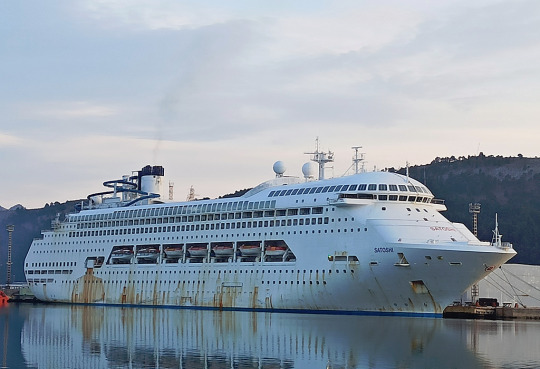
The Satoshi was a cruise ship owned by Ocean Builders, a company dedicated to "seasteading," an attempt to create a seabourne community free of laws imposed on dry land, with strong ties to the cryptocurrency movement.
The 1991-built ship, originally named Regal Princess but renamed Pacific Dawn in 2007, was purchased by Ocean Builders in the middle of the Covid-19 pandemic in 2020. The idea was to permanently anchor the ship in Panamian waters, as the central hub of an eventual community of "SeaPods", essentially individual houses at sea, which would be arranged around the Satoshi in the form of a Bitcoin B.
It quickly became evident that the people running Ocean Builders had no understanding of how to operate a ship: they initially failed to ensure their ship had certificate of seaworthiness to allow it to sail to Panama (where the venture was to be based), and even after this no-one was willing to insure the ship, making it impossible for passengers to live onboard. They also planned to re-engine the ship while it was out at sea, a physically impossible task to accomplish without sinking the ship in the process.
The leadership of Ocean Builders blamed all this on shipping being "plagued by over-regulation." (Many of our entries here at Today's Problematic Ship demonstrate those regulations exist for a reason). The end result was predictable: by the time the Satoshi arrived in Panama it had been sold to an Indian shipbreaker.
Except Ocean Builders had signed a contract they could not honour: according to the Basel Convention, which covers the disposal of hazardous waste, they weren’t allowed to send the ship from a signatory country (Panama) to a non-signatory country (India). Thus the sale was cancelled, and subsequently the ship was arrested by Panamian authorities.
Eventually, the Satoshi was sold in 2021 a different startup company, Ambassador Cruise Line. The new venture, who actually knew how to operate a cruise ship, started successful operations with the former Satoshi, now renamed Ambience, in 2022.
The Guardian has a detailed article about the saga of the Satoshi and the seasteading movement.
1K notes
·
View notes
Text
"We want justice,” doctors chanted in Kolkata, waving handwritten signs that read, “No safety, no service!”
16 Aug 2024
Indian doctors have called for a nationwide shutdown of hospital services as public fury over the rape and murder of a trainee medic in the eastern city of Kolkata last week mounts.
The Indian Medical Association (IMA), the country’s largest grouping of medics with 400,000 members, said the 24-hour shutdown would be implemented on Saturday, affecting most hospital departments except for essential services.
The shutdown comes after thousands of people took to the streets in several cities to express their outrage at the rape and murder of a 31-year-old trainee doctor, whose brutalised body was found on August 9 at Kolkata’s state-run RG Kar Medical College and Hospital.
On Friday, large protests were held in various cities – including Kolkata, the capital of West Bengal state, Mumbai in the west and Hyderabad in southern India – demanding justice and better security at medical campuses and hospitals.
“We want justice,” doctors chanted in Kolkata, waving handwritten signs that read, “No safety, no service!”
Demonstrators held banners calling for accountability as they gathered near parliament in New Delhi.
“Doctors, especially women are vulnerable to violence because of the nature of the profession. It is for the authorities to provide for the safety of doctors inside hospitals and campuses,” the IMA said in a statement issued on Thursday on X.

Doctors hold posters and shout slogans during a protest condemning the rape and murder of the trainee doctor, at a medical college in Ahmedabad, western India, on August 16 [Amit Dave/Reuters]
Multiple medical unions in both government and private systems have backed the strike.
Doctors in government hospitals across several states on Monday had halted elective services “indefinitely” in protest.
Indian media have reported that the murdered doctor was found in the teaching hospital’s seminar hall, suggesting she had gone there for a brief rest during a long shift.
An autopsy confirmed sexual assault. Doctors say the circumstances of the rape point to the vulnerability of medics left without proper protection and facilities.
Though police have detained a man who worked at the hospital helping people navigate busy queues, state government officers have been accused of mishandling the case.
On Wednesday night, the hospital where the trainee doctor was killed was attacked. Police did not identify who was behind the rampage, but said they have arrested 19 people so far.
Little has changed
There were more than 31,000 reported rapes in India in 2022, the latest year for which data is available, according to the National Crime Records Bureau (NCRB).
The gang rape and murder in 2012 of a young woman on a bus in Delhi, northern India, led to nationwide protests and outrage over the country’s failure to tackle sexual violence against women.

Since 2012, the government has brought in sweeping changes to the criminal justice system, including tougher sentences and the death penalty for repeat offenders.
Conviction rates for rape ranged between 27-28 percent from 2018-2022, according to NCRB data.
The definition of rape has also been widened to include non-penetrative acts and the age threshold for rape trials lowered so 16-year-olds can be tried as adults.
But campaigners say little has changed despite the tougher laws.
Criminal lawyer Rebecca M John, who has represented many rape victims, said some rapists still believe they can get away with their crimes.
“One of the factors would be the absence of fear of the law,” she said.
Many cases of crimes against women also go unreported because of the stigma surrounding sexual violence and a lack of faith in the police.
#India#Kolkata#The Indian Medical Association (IMA)#RG Kar Medical College and Hospital#Male violence#Violence against women#There were more than 31000 reported rapes in India in 2022#May she Rest In Peace
24 notes
·
View notes
Text
I wasn’t tagged but I saw this game on my dash and thought it was fun so here we go.
#motogppolls#f1 polls#(kinda)#surprisingly could find more f1 things than I initially thought#even got some more not named here
16 notes
·
View notes
Text
i’ve recently come across an insightful video analysis that was reposted on tiktok, explaining the Gaza situation in depth and touching on the geopolitical and economic motivations that background it, along with the potential impact from the ethnic cleansing and the active genocide of Palestinian people by zionists. here’s a summary with some links to more-reputable news articles:
-roughly around a month ago, netanyahu declared his plan for a “new middle east,” an economic corridor stretching from India to the European continent, through the UAE, Jordan, Saudi Arabia, and “israel.”
-due to the weakening of the US Dollar, this “new middle east” corridor serves as a hopeful (on their part) counter to China’s new ongoing “silk road.” it’s essentially a move for leverage on world economics, trade, and politics.
-Russia is the country with the largest proven reserves of natural gas. in 2022, Nord Stream 1 and 2 (Russia’s gas pipelines) were both blown up. sanction packages from EU ban Russian gas. no more Russian gas coming into Europe.
-Iran, the country with the second largest gas reserves, signs the Nuclear Deal in 2015-2016. the US backs out of the deal and reimpose harsh sanctions on Iran. Iran is barred from selling its gas and oil to Europe and others.
-with Russia and Iran out of the picture, “israel” (US-backed) proposes itself as a solution to EU’s gas shortages. in 2010, they find the Leviathan—a giant gas field in the middle east (Mediterranean Sea), off the coast of Palestine, Lebanon, and Syria.
-Syria initially declines offers over its gas reserves; the US now controls 1/3 of Syria and all its oil fields, and “israel” regularly bombs it’s most vital port (Latakia). another major port is in Beirut, which mysteriously exploded in 2020. both Syria and Lebanon’s maritime activity are limited, including in trade and gas exploration.
-Gaza, also having its own unexplored gas fields, has been under siege, under naval blockade since 2007. the only working port left in the coast is haifa port in “israel.” “israel” is now the only one able to explore gas and implement an economic corridor, like the proposed “new middle east.” what the US and “israel” have essentially done is killed off the competition, stole their goods, and cornered the market.
-in light of Europe’s gas shortages, to get them gas before winter, “israel” attempts to “stabilize” the region by solving “the Palestinian question”—more than displacement, they’ve resorted to ethnic cleansing and genocide. basically an acceleration of their plan.
-what Palestinian resistance groups have done in response was because they were backed into a corner. tooth and nail, life or death. it did not happen in a vacuum.
it has always been a move for natural resources; Palestine, Syria, Congo—every move for destabilization framed as intervention. it has always been greed for capital.
update:
it’s come to my attention that the video in question might have some more pro-Russian leaning stances, and so i’ve deleted the google drive link to the reposted tiktok and the link to the actual tiktok as i do not wish to platform the denial, partial or in whole, of the atrocities done to Ukrainian people. i will keep the summary up with some parts omitted because i still do think it is an insightful analysis in general and i do think the knowledge is still useful and relevant.
#peace is not the answer; liberation is the answer#resources#palestine#free palestine#free gaza#gaza strip#please look into other resources within the first and second tags in this post too
79 notes
·
View notes
Text
Preserving Leaf Paintings in an Anglo-Indian Commonplace Book, 1822-1825
Hello, I’m Alexa Machnik, a third-year graduate student at the Conservation Center, Institute of Fine Arts, NYU. I first came to the Barbara Goldsmith Preservation & Conservation Department in Fall 2022 as a student in the graduate course, Conservation in Context, taught by Laura McCann, Director of Preservation. During this course, we delved into the world of library conservation, exploring the value systems that guide preservation decision-making and treatment action in academic research libraries. One of my class projects involved rehousing delicate leaf paintings from an early 19th-century commonplace book, or friendship album, part of the Fales Library holdings in the Special Collections at NYU Libraries (figs. 1-2) [1]. In honor of Preservation Week, I will share the intriguing history of the book and discuss the decisions that were made to preserve the leaves.
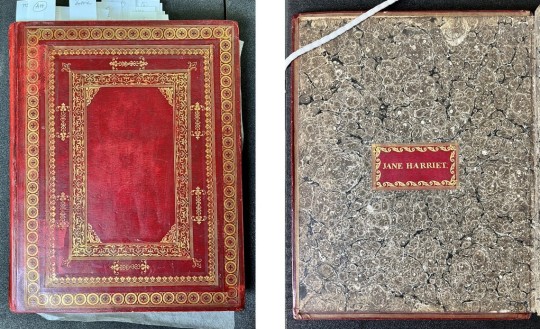
Figure 1 [left]: Front cover of the commonplace book, bound in gold-tooled red morocco leather. Figure 2 [right]: Ownership label of “Jane Harriet [Blechynden]” on front marbled pastedown.
The book in question was compiled by Jane Harriet Blechynden (1806-1827) in England between 1822 and 1825. It holds her personal collection of handwritten and acquired materials, with contributions from her sisters, Emma and Sarah, who wrote original poems about sisterhood, separation, and their Anglo-Indian ancestry. The three women were the daughters of a British merchant residing in Calcutta, and while born in India, they were educated in England [2]. There is not a great deal known about Jane Harriet’s life in England, but her impending return to India in 1825 is documented in an emotional verse by Emma (fig. 3):
“Thus in parting my sister we’re breaking a link / Which may ne’er be united again / And firm as that chain was ‘tis painful to think / That absence may send it twain.”

Figure 3: Excerpt from the original poem, “Parting and a Meeting,” signed by Emma.
Jane Harriet’s book offers insights into her personhood, social connections, and sensibilities as an artist and collector. In addition to written entries, she inserted a compendium of acquired materials–pressed flowers, her own original drawings, and numerous paintings–between pages of the book (figs. 4-6).

Figures 4-6 [left to right]: A small sampling of the ephemeral treasures found in the book, including a dried pressed flower, a drawing on pith possibly by Jane Harriet, and a cut-paper silhouette.
Notably, six of these paintings are executed on the dried leaves of the Bodhi tree, a sacred plant indigenous to Asia with distinct spade-shaped, long-tipped leaves (fig. 7) [3]. Although leaf painting has origins in Buddhist traditions, by the time Jane Harriet collected her leaf paintings, it had already evolved into a form of Chinese export art in Europe. Her leaves depict secular scenes of contemporary life in China and botanical subjects, which are typical of the export genre (fig. 8). Their inclusion in the book implies that Jane was among the many people who partook in the avid collecting of China trade goods during the first few decades of the 19th century, a time when European fascination for Chinese culture and art was at its peak.

Figure 7: A leaf painting, as found loose in the book and partially lifted to show the thin, translucent nature of the leaf support.

Figure 8: Another leaf painting from the book, oriented with the leaf tip at the bottom of the image, depicting flowers and a butterfly.
The initial rush of excitement that I felt at finding the leaf paintings soon turned to concern as I gave thought to their long-term preservation at NYU Libraries, where researchers are expected to handle the book. The leaf paintings were loose in between the pages, which raised a series of “what ifs” about the potential dangers they could encounter. What if the leaves slip from the book? What if they bend or break as the pages are turned? What if the painted surfaces become abraded? The paintings were made with opaque pigment-based watercolors on exceptionally delicate, skeletonized leaves that have been primed with a thin organic coating. Despite being intact, their inherent fragility means that they are vulnerable to even the slightest touch. After considerable discussion, the Conservation Unit decided that in order for the leaf paintings to be preserved and safely accessed by researchers, they should be housed separately from the book.
I thoroughly examined the condition of the leaves and the painted surfaces in order to make a housing recommendation. Despite some minor damage, all were in stable condition. Thus, the ideal housing would provide support to prevent any further damage, such as paint loss and leaf breakage, and at the same time allow the leaves to maintain their translucency. To achieve this, I opted to mount them in double-sided window mats with a support made from clear polyester film, or Mylar® [4]. The addition of the Mylar® would not only create a stable surface for the leaf paintings but also enable the viewing of both sides (fig. 9).

Figure 9: View of the double-sided window mat with a Mylar® support.
My next challenge was to figure out how to mount the leaves onto the Mylar® support without the use of adhesive [5]. After consulting with conservation staff and creating mock-ups, short, discreet Mylar® tabs were selected as the best option to secure them into place (figs. 10-11). For this process, I positioned a single leaf painting onto the support and selectively placed the tabs around its perimeter, making sure the tabs did not overlap any areas of paint. I then used a handheld spot-welding pen to fuse the tabs to the support. Since this process was done in-situ, near the leaf, it required lots of precision practice and encouragement from colleagues before I felt confident enough for the task.
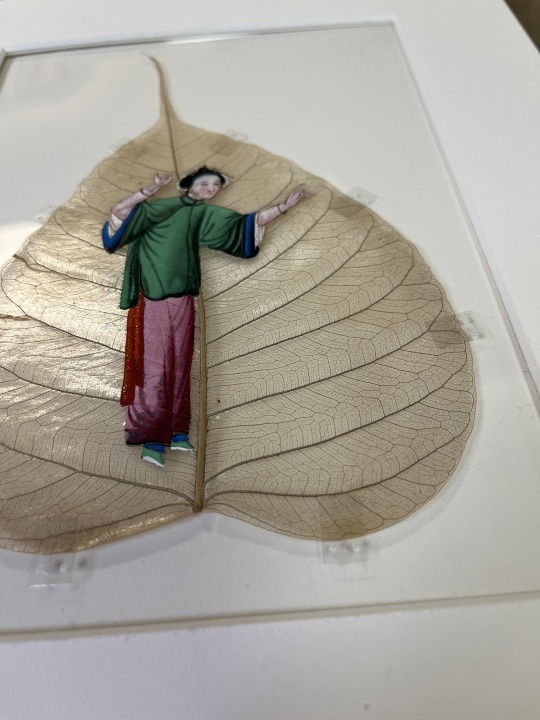
Figure 10: Detail of a mounted leaf painting. Notice that the Mylar® tabs are welded just outside the leaf and extend minimally over the edges, holding it in place with gentle pressure.
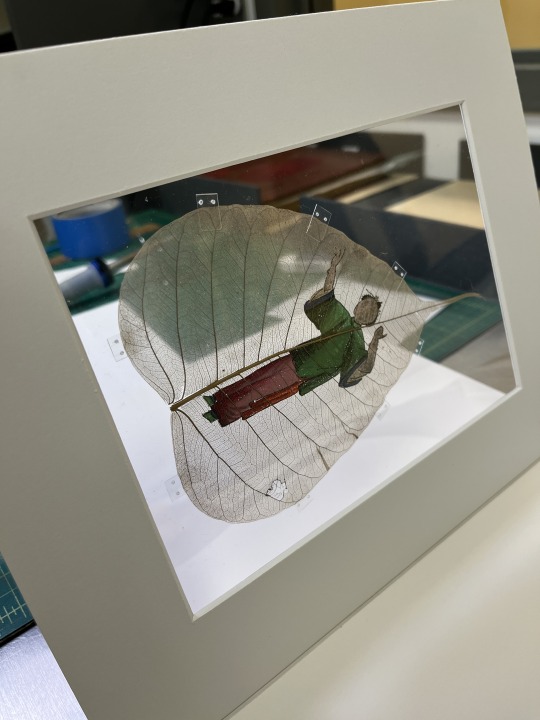
Figure 11: The backside of a mounted leaf painting viewed through the Mylar® support. This gives researchers access to the painting’s verso, where an underdrawing and other signs of artistic process can be discerned.
At the time of writing this post, I successfully housed the six leaf paintings in their double-sided window mats (figs. 12-13). This housing project, while complete, is just one part of the ongoing effort to preserve the commonplace book, and the Conservation Unit is continuing work on other elements of the book to ensure its safe return to Special Collections.
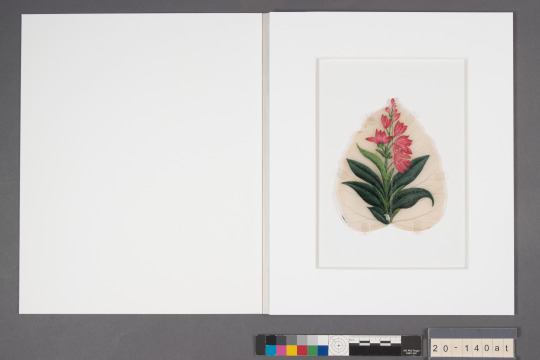
Figure 12: Example of the completed housing, showing the front of a leaf painting.

Figure 13: Back of a leaf painting.
Though my involvement in the project has come to an end, I have gained a very special appreciation for the commonplace book and the preservation challenges it presents. The experience of learning directly from NYU Libraries Special Collections was especially invaluable, providing me with opportunities to participate in complex decision-making processes unique to large research libraries driven by user needs. Before signing off, I’d like to extend my gratitude to my supervisors, Laura McCann, Director, and Lindsey Tyne, Conservation Librarian, and the entire team at the Barbara Goldsmith Conservation Lab for their unwavering support and enthusiasm throughout this project. Thank you all very much!
Notes:
[1] A commonplace book is a centralized place for an individual to record information, whether it be their personal thoughts or quotes from outside literary sources. Friendship albums, by contrast, contain handwritten entries from the family, friends, or acquaintances of the owner (often female). Both forms of commonplacing sustained popularity in Europe and America throughout the 19th century. To learn more about this fascinating literary genre, see Jenifer Blouin, “Eternal Perspectives in Nineteenth-Century Friendship Albums,” The Hilltop Review, Vol. 9, Issue 1 (2016) and Victoria E. Burke, “Recent Studies in Commonplace Books,” English Literary Renaissance, Vol. 43, No. 1 (2013), 153-177.
[2] Much of what is known about Jane Harriet (also known in her family as Harriet) comes from the Blechynden papers in the British Library (Add. Mss. 45578-663). This large holding contains the diaries of her father, Richard (Add. Mss. 45581-653), and older brother, Arthur (Add. Mss. 45654-61). For a secondary account of the Blechynden household, see Peter Robb, Sentiment and Self: Richard Blechynden’s Calcutta Diaries, 1791-1822 (New Delhi: Oxford University Press, 2011).
[3] Michele Matteini, “Written on a Bodhi tree leaf,” Anthropology and Aesthetics, Vol. 75-76 (2021), 45-58.
[4] The design of the double-sided mats is based on an instructional guide made available by the Library of Congress. “Double-Sided Mat,” Library of Congress, accessed 1 February 2023.
[5] We chose not to use adhesives or traditional paper-hinging techniques to mount the leaf paintings for several reasons. As noted, the paintings are on fragile, non-paper-based supports that have an organic coating, which may be derived from plant gum. The leaf supports are thin, translucent, and highly vulnerable to breakage, so applying hinges directly with adhesive might permanently alter their appearance or risk further damage to the leaves over time, especially if they need to be removed from the housing in the future.
Photographs: Alexa Machnik
#NYULibraries#NYUSpecialCollections#FalesLibrary#nyuifa#nyuart#librarypreservation#libraryconservation#collectionscare#artconservation#paperconservation#bookconservation#artpreservation#preservingthepast#PreservationWeek#preservationweek2023
211 notes
·
View notes
Text
This week’s BRICS summit in Kazan, Russia, features a new participant: Turkey. A Kremlin official leaked last month that Ankara had applied to join the grouping, following repeated expressions of interest over the years. A spokesperson for Turkish President Recep Tayyip Erdogan’s ruling Justice and Development Party (AKP) then conceded that “a process is underway.”
The BRICS grouping undertook a major expansion recently, adding Egypt, Ethiopia, Iran, and the United Arab Emirates in January, with Saudia Arabia still mulling whether to join. The acronym stands for the group’s original members: Brazil, Russia, India, China, and South Africa.
Still, Turkey’s BRICS application is a watershed moment in geopolitics. If Turkey joins BRICS as a full member or partner state, it would become the first NATO member and longtime candidate for European Union membership to have an active role in an entity seen by some analysts as a challenger to Western predominance.
Turkey’s diplomatic demarche is yet another sign that the global south is rising in world affairs, and it underscores the growth of active nonalignment as an ideology. But it is not a major break in Turkish foreign policy: Ankara’s BRICS application is an extension of its international balancing act, which aims to diversify alliances while maintaining ties with the West.
During two decades in office, Erdogan has promoted a non-Western-centric vision of the world and sought greater global autonomy due to frustration with the EU and the United States. For its part, BRICS is on a roll in terms of both membership and growing global clout. In addition to Turkey, countries such as Malaysia and Thailand have also applied for entry and sent envoys to this year’s summit.
Cooperation among BRICS members in energy, trade, and infrastructure development is growing at a fast clip. As a share of global trade, intra-BRICS trade in goods more than doubled from 2002 to 2022, reaching 40 percent. In 2015, the group created the Shanghai-based New Development Bank with $50 billion in capital. The bank, headed by former Brazilian President Dilma Rousseff, has since lent $33 billion for 96 projects.
BRICS now aims to create an alternative payment system to SWIFT, which it perceives as a Western-dominated international banking system. The project has taken on greater importance after Western countries disconnected Russia from SWIFT following the country’s 2022 invasion of Ukraine.
BRICS would benefit from Turkey’s accession. From a geopolitical standpoint, Turkey’s membership would enhance the group’s stature as a proponent of nonalignment, as opposed to a bloc with an anti-Western agenda—though it would certainly increase Western suspicions about Turkey. At present, the group is torn. China and Russia would like to build it into an anti-Western entity, while Brazil, India, and South Africa would prefer it to take a stance closer to nonalignment. Turkey’s presence is likely to strengthen the second view. The same goes for most of the new members, except for Iran, which is likely to hew close to China and Russia.
Joining BRICS would also put Turkey, a NATO member, in a privileged position: Having a foot in both camps increases Ankara’s foreign-policy leverage. “Being involved in these structures does not mean abandoning NATO,” Erdogan told journalists at the United Nations General Assembly in September. “We do not think that this alliance and cooperation are an alternative to one another.”
Despite Erdogan’s high profile in global affairs, Turkey’s domestic agenda has become increasingly challenging for the president. In March, the AKP lost ground in municipal elections, while economic growth has slowed and inflation runs rampant. But domestic constraints have not limited Turkey’s quest for influence across Eurasia; if anything, these international endeavors offer a welcome distraction.
Erdogan’s foreign policy is built on a complex blend of Turkey’s Ottoman legacy, nationalist aspirations, and a sense that the West’s best days are behind it. He seeks a more multipolar world, where Turkey can act independently of Western hegemony and search for strategic options beyond the West, even if this means partnering with historical enemies, such as Russia, or with countries that have pursued draconian policies against Muslim minorities, such as China.
Erdogan has sought to expand Turkey’s strategic wiggle room through diplomacy. He has signed energy deals with Russia, allowing the Russian state-owned utility Rosatom to build, own, and operate Turkey’s first nuclear power plant; mediated in armed conflicts such as the Russia-Ukraine war; and rallied support against Israel’s military actions in Gaza.
Turkey’s BRICS application is no different. It is not about breaking ties with the West but rather recalibrating them in favor of broader and more diversified alliances that are important to Turkey’s long-term national interests—particularly as Ankara’s prospects for EU membership grow dim and strategic ties with the United States weaken.
Turkey’s decades-long bid for EU membership has been marked by frustration. As Ankara has pushed for accession, EU responses have been lukewarm at best, especially after French and German opposition in the late 2000s. With a population of 87 million people, Turkey would be the largest country in the EU and the only Muslim-majority member. Democratic backsliding after the 2013 Gezi Park protests and the 2016 coup attempt have not helped its case. Today, while Turkey remains a candidate officially, its EU accession talks have stalled.
EU ambivalence over Turkish membership stems from concerns over Turkey’s human rights record and growing authoritarianism under Erdogan’s leadership. There are also disputes over Cyprus and maritime rights in the Eastern Mediterranean. The 2023 European Commission report on Turkey further strained relations; the report condemned Ankara’s democratic erosion and suggested that it is nowhere close to reaching full membership.
Turkey’s links with the United States have not fared any better. A major point of contention was Turkey’s purchase of the Russian S-400 missile defense system, which led to its removal from the F-35 fighter jet program. In response, Turkey opted for F-16s, taking advantage of the Russian invasion of Ukraine to upgrade its defense industry. The conflict also increased Turkey’s leverage over NATO, particularly as it stonewalled Sweden’s bid for membership.
Amid the war in Gaza, Erdogan’s alignment with the Palestinian cause and vocal criticism of Western support for Israel have deepened rifts between Ankara and Washington. In the past, the Turkish president also blamed the Obama administration for its support for the Kurdish-led Syrian Democratic Forces during the Syrian civil war, an issue that has lingered.
All the same, Turkey has proved that it is still indispensable to the West: It has acted as a key mediator in the Russia-Ukraine war, underscoring its delicate balancing act between NATO commitments and partnership with Moscow. In this role, Turkey has achieved impressive results—such as facilitating the largest prisoner swap since the Cold War.
For Erdogan, these developments have confirmed Turkey’s need to pursue a form of nonalignment and to shift its focus toward the global south and non-Western entities. Turkey’s pivot has led it to engagements across the Middle East, Africa, and Latin America, where Ankara has expanded its networks and business. In this context, BRICS offers Turkey a unique opportunity to join a rising bloc that represents a significant portion of the global south as well as Russia and China—key actors in Eurasia.
In a world marked by great-power rivalry and competing grand narratives, Turkey stands to regain its role as a bridge between the West, global south, and Eurasian powers. The country’s unique position draws on its geographical location and imperial history. By applying to join the BRICS—an informal yet high-profile group—Turkey is signaling to the West that it should not be taken for granted.
7 notes
·
View notes
Text
GUESS WHAT THE ESSAYS DONE
So its like 2k words lol
So let’s talk about Checo Perez and Logan Sargent’s treatment in F1. Checo is 34 and has been in the series since 2011 after a really successful early carer in both karting and the junior series. Logan Sargent is 23 and also had a very successful carer in the lower classes. When Checo was in karting the lowest place he got in the championship was fourth. He was the youngest driver to be champion in The Karting Youth Course. Then in 2007 he switched to British Formula 2, and won the series on his debut with podiums in two thirds of the races. He continued this trend into his later years in F2, and in 2008 he was the first Mexican driver to compete at that level since Giovanni Aloi. Then he joined Formula One, debuting with Sauber. He was the fifth Mexican to compete in F1 and joined the Ferrari driver academy in October of 2010. This is a lot of information all at once but it does show that Checo was a good driver from the beginning, he was consistent and fast. However in 2011 Sauber was a lower field team and as a result he struggled a lot to be competitive in the championships. This continued when he joined McLaren in 2013 because they were also a midfield team at the time. According to his teammate Jenson Button during the Bahrain Grad Prix of that year, “He’s extremely quick and did a great job today-“.(ESPN) Checo was driving very aggressively against his teammate and they collided a couple times on track. He started doing better and getting podiums but he encountered a lot of car issues dUe to his car being a midfield competitor. He was showing improvement at the end of 2015 when he finished ninth in the standings. He continued to improve into 2017 and 2018 when he switched to Force India. He got his 8th carer podium finish in Azerbaijan in 2018 and was the only non RedBull, Mercedes, or Ferrari driver to podium that year. Then he won in Sakhir from last place, which makes him the first Mexican driver to win in over 50 years. After that he signed with Redbull in 2021. He was doing a lot better, finishing the season in fourth and was consistently in the top ten during races. Even very early into their run together Max considered Checo a great teammate saying” Checo is an amazing human being. Not only just to work with in F1 but a super nice person-“He continues later in the article with, “It’s very rare to have a team mate like that and what he showed today, he was a real team player and I really hope we can continue this for a long time.” (formula1.com) This will become relevant more later when we start to talk about the current season, but its important to keep in mind that even in December of 2021 Max considered Checo a good driver and teammate. Checo would continue to do better, getting third in the championship in 2022 and winning in Monaco in the wet. And then got his 20th carer podium in Azerbaijan of that same year. He consistently got 1-2s with his teammate and helped hold off other cars. In 2023 he continued this by helping defend against the McLarens and Ferraris and as a result helped create massive gaps in the field. He ended the Championship in second and continues to be Max’s teammate at Redbull until 2026. Overall Checo is a good defensive driver, he tends to be very consistent and is good at overtaking. When he is in a good car he can drive very well, and he is a good teammate for Max Verstappen due to his more calm attitude and driving skills.
Logan also has a similar record albeit a significantly shorter one. During his 2008 karting debut he got third, then he got another third place in a second karting series that same year. He was the first American to win the CIK-FIA World KFJ Championship (yes that is the real name of the championship)since 1978. In his UAE F4 debut he podiumed in fifteen out of the 18 races and ended the championship in second after his teammate. The following year, 2017, he got third behind his teammate, and future competitor, Oscar Piastri. He continued this patter of high championship standings until he joined Formula 3. He ended up getting 19th in the championship, which is very low but he wasn’t in last place. He joined Prema racing in 2020 and started doing better again. He finished the championship in third that year, but he left Prema the following year and ended the season in seventh. He moved up to formula 2 after being backed by the Williams academy. In 2022 he had his first practice F1 debut, which makes him the first American F1 driver to participate in a Grand Prix weekend since Alexander Rossi in 2015. Then he joined the Williams Formula one team in 2023, he was the first Williams academy driver to drive for the team. And the first Williams driver to be a rookie under James Vowles. Who was the new team principal of Williams. The team was not doing well, they struggled to get points and generally function. But Logan was the first American to score a point in F1 since Micheal Andretti in 1993. In 2024, Willams decided to make Logan give up his car after Alex Albon’s crash during the Australian Grand Prix’s practice, citing the team forgot their spare chassis. After that, there were a couple races where Logan was racing with a rear wing and other parts from last year’s car. Overall Logan reminds me a lot of when Alex drove for Redbull during his debut. Logan was very good in the junior series and I think he could be better if he was given a car that wasn’t like wrangling an angry goat every weekend and maybe another year in F2. It would also help if he had a car that was fully updated and not use essentially as Alex’s backup car.
Both Checo and Logan had pretty similar results in their junior series and karting years. I think the biggest difference between Checo and Logan is that Checo always had a purpose to the team, he was never meant to be disposable. Checo, with his defensive skills helps create large gaps between Max and everyone else, Logan was meant to show that Williams was no longer Mercedes’ feeder team. Which he has in a way, by showing just how much Williams is drowning. Logan was pulled into F1 too early and it shows, if he was given another year he probably would have done better. With Checo they have to be keeping him on for a reason even though he’s been lackluster this season, and the public probably doesn’t know what it is. Redbull, if anything have a talent for throwing out underperforming drivers, we’ve seen it happen countless times, like with Pierre Gasly, Alex Albon, and Daniel Ricciardo. If Checo didn’t have something the team wanted he would have been replaced by now, we all know that Helmut wants him gone. And like on that, most of the talk of Checo being kicked stems from Helmut, you know, the guy who has a history of being racist to Checo. Why would people believe the number one rumor spreader in the paddock as if he’s a reliable source? I think the only commonality between Redbull and Williams is their team principal’s being embarrassingly unprofessional at the driver’s expense. If I was seeing that my boss was saying that I was going to lose my seat every race weekend I probably would be stressed too, especially if the car is clearly not working. How is it that Max Verstappen himself said that the car sucked and there was no need to worry about Checo and yet people are still blaming Checo? The car is already built around the hyperspecific needs of the number one driver which has proven to be incredibly hard for most other drivers to drive, and it isn’t working this year. At some point you have to starting thinking critically about the team. If the data isn’t matching up in the sim when applied to the actual car then there a bigger fish to fry than a teammate who’s doing okay in a more competitive season.
At least we know that both teams share an air of unprofessionalism around their second drivers. Doesn’t it rub you the wrong way when you read about James publically talking about him thirsting over Carlos Sainz as soon as it was announced he lost his seat? Loudly? Over and over again? I think it was all over in Australia, I’ve never heard of a team making their driver give up his car for his teammate. And how do you just have your spare Chassis unavailable? I genuinely believe Logan was rushed because James wanted two things from the young driver. One, he wanted to show that Williams wasn’t a feeder team into Mercedes anymore. And two, he wanted someone to essentially be fodder to test things on until they figure stuff out. I don’t think James would have been so adamant about trying to get a new driver if it wasn’t Carlos Sainz, due to his knowledge of engineering. Redbull on the other hand, has Helmut Marko, he constantly complains about Checo’s pace and while that’s a good point, he isn’t doing well, at some point you have to actually help your drivers. It also doesn’t help seeing yourself being insulted on social media. During this years Dutch Grand Prix practice 1 Checo got 12th and most of the comments on Redbull’s post were insulting Checo. But then during the testing at the beginning of this season when both drivers were doing poorly, all the comments were worried that the team was sandbagging and hoping that they would do well in the race. Checo also gets a lot of bias against him in the media, especially the British media and Sky sports announcers. It’s once again a thing of only bringing up Checo being Mexican when he’s doing poorly but when he’s doing well he’s a Redbull driver. A similar thing happens to all the other drivers who aren’t white and European. I also looked at the Willams posts about the practices and everyone showed more pity for Logan, saying things like “I really feel very sorry for him” Ect. In fact I only saw one direct insult, “Least he’s winning the world destructors championship”. And then I looked at another practice post to make sure the results weren’t skewed due to his crash, and no it was actually better, most of the comments were calling for Logan to get a better car, or believing Logan could be a good driver later. However both of the driver’s personal instagrams have only positive comments as far as I can see. But I do remember there was a period when Checo would get a lot of hate comments on his posts. It’s interesting to me how people can acknowledge that Logan is struggling due to his car but they can’t do the same to Checo even when 1. His teammate is complaining about the car, and 2. These same people will say that Max’s ex-teammates struggled due to the car. I wonder if it’s because Checo has been driving for so long and was pretty successful compared to Logan who was beaten down since he started.
TL;DR Checo and Logan are in a way set up to fail with their cars. Checo, with the car being so geared towards Max it’s incredibly difficult to drive and on top of that it’s not a very good car this year period. And Logan well, he was set up to fail from the beginning. He was pulled from F2 a year too early and he never had the same amount of test driving that the other rookies of his time had, Oscar for example had a trial in an F1 car a full year before Logan did. As well as having three tests with McLaren before debuting but Logan only really had one.
#unintelligible goblin noises#f1#tabby rambles#formula 1#tabby!!!#checo perez#redbull racing#helmut Marko mention:(#williams racing#logan sargeant#Two weeks of research put to use lol#I hope the mutuals who were excited about this enjoy it^^
8 notes
·
View notes
Text
MileApo x Dior Gateway to India Press
Featured in the New York Times (text mention):

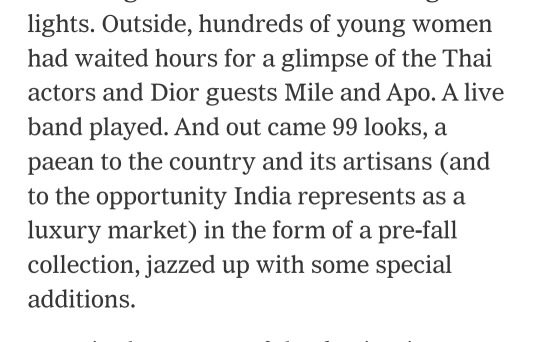
In the Associated Press:


Western celebrities of Indian origin or descent — like Freida Pinto, Simone Ashley of “Bridgerton”, sitarist Anoushka Shankar and Vanity Fair editor-in-chief Radhika Jones — took in the show. Other guests included actor Maisie Williams from “Game of Thrones” and Thai actors Mile and Apo from “KinnPorsche.”
In GQ India (twitter/IG post)

Via their website:
Among global celebrities, Thai superstars Phakphum Romsaithong and Nattawin Wattanagitiphat created an unprecedented stir. They were greeted by a massive legion of local fans, who lined the streets of Colaba, screaming their names and holding up posters.
In the Indian newspaper The Hindu

In Rediff:


In Hello! Magazine India:

While not new to anyone familiar with the world of BL dramas that has only expanded since the pandemic, Mile and Apo sparked a curiosity in many, especially because of the grand welcome they received at the Mumbai airport, with fans queuing up for hours to catch a glimpse of the stars, and the interest they garnered online despite being surrounded by some of the biggest names in the fashion and entertainment industry.
So who are Mile and Apo?
Mile Phakphum Romsaithong and Apo Nattawin Wattanagitiphat are actors from Thailand, most popular for their roles as Kinn and Porsche in the hugely successful BL series KinnPorsche (2022).
The success of KinnPorsche catapulted the actors into global stardom with a fandom that expanded across the globe, as evidenced by the warm welcome they received by hundreds of fans in Mumbai. Aside from collecting awards and covers of all top magazines in the country, the main lead actors from the drama also scored a coveted Dior ambassadorship that led them to be invited for the label’s pre-fall 2023 ready-to-wear showcase in Mumbai recently.
(wait really?! did Hello jump the gun and leak that information before it was meant to be released, or maybe they misunderstood, or is that how we're gonna find out???)
By the French Embassy in India:


Mile in Badhombre, a Spanish publication, in their best dressed of the week. (the difference is in the details) this is a sign I need to shut up about how I think Dior is ugly I guess...

And of course many of the usual places that have now been covering them like Harper's Bazaar SG (Thank you Kenneth Goh), Vogue Thailand, Vogue HK, and Dior directly on their IG and Twitter accounts.
Our babies are huge big stars 🥺 New York Times!!!
100 notes
·
View notes
Text
The Sign of Four: In Quest of a Solution
You could find the back issues of most papers just by visiting a local library. Today, the British Newspaper Archive will, for a monthly subscription, allow you to look at a whole slew of vintage papers, including The Illustrated Police News for all your Victorian "true crime" reportage.
As mentioned before, a four-wheeler was a four-wheeled carriage with a driving seat on the top front and a luggage rack on the top; they costed more than the hansoms.
Doyle isn't very good with coming up with convincing Indian names, is he? Singh is the name used by a baptised male Sikh (Kaur is the female equivalent) i.e. a turban-wearing, dagger carrying one. Mahomet is a version of Mohammed.
The gas lights of London weren't hugely bright compared with modern street lights; you'd be able to find your way, but there's probably a decent chance you'd step in horse exhaust if you weren't careful.
The Lyceum Theatre, located on Wellington Street, dates back to 1765, but the current building is from 1834, rebuilt after a fire. It contains a balcony over the dress circle, a unique theatre.
GhostApple on Tumblr pointed out that Bram Stoker was the manager at that theatre at the time SIGN was released. The theatre at the time was run by Henry Irving and Ellen Terry, two of the biggest stars of their days, becoming Sir Henry and Dame Ellen later in life. Stoker based Dracula on Irving, but sadly Irving never actually played the Count on stage.
After a further rebuild, time as a ballroom, a demoliton threat and two closures, the Lyceum reopened in 1996 and is a Grade II* listed building, the second highest grade. Since 1999, it is the London home of The Lion King.
The normal garb of a coachman would be a top hat and a heavy double-breasted overcoat; they would be driving their vehicle in a vast array of weather conditions, sometimes on the same day as anyone who has lived in Britain can tell you.
The coach is going rather fast at this point, possibly dangerously so. The Offences against the Person Act 1861 created an offence of "causing bodily harm by wanton or furious driving"; which could mean that if a horse-drawn vehicle hit another vehicle or a person, the driver could get up to two years in prison. The offence remains on the books, being used against horse-drawn carriage drivers (still a thing, particularly in the Traveller community), motorists when not on a road or public land and cyclists, as the Road Traffic Act 1988 is not available in these cases - it is a Crown Court-only offence. In 2017, a cyclist riding at speed in East London with no front brakes hit and killed a woman; the jury found him not guilty of manslaughter, but convicted him of this offence, with the result he got a 18-month sentence.
Tiger attacks were very common in British India; tigers are known to attack humans when feeling threatened (human encroachment on their territory is a big problem)), injuries prevent them from going after other prey or they mistake a human for something else, or if one is riding a bike, their chase instinct may kick in. 33,247 people were killed by tigers between 1876 and 1912. In 2022, the Indian government recorded 112 tiger-caused deaths, up from 59 in 2021. Some tigers have ended up killing over 100 people before being shot dead.
For those having a go at Watson for shooting at a tiger cub, we don't know how old or how big the tiger cub was. A newborn tiger maybe less than 10 pounds and look adorable, but a ten month male could easily be over 100 pounds and looks rather like a full-grown adult. Especially in the dark.
This said, humans are a good deal worse than tigers. The British cleared vast amounts of their habitat for the timber to build their railways. Hunting tigers for "sport" had been a common practice for the Indian nobility and the British ruling classes liked doing it just as much, bringing modern firearms along. Remember Dr. Sterndale from DEVI? There's a chance Watson might have gone hunting himself, sadly.
The tiger hunting got worse post-independence as improved air travel made it easier for game hunters to get to India. The Indian government banned tiger hunting in 1972 and the Bengal tiger population is slowly recovering. The size of reserves have not kept up with the population and so some tigers have gone into human areas for food, usually livestock but sometimes humans. If a tiger starts killing people and attempts to tranquilise it fail, then lethal force will be authorised. In 2022, T-104, a three-year-old dubbed the "man-eater of Champaran", killed nine people before he was shot dead by the police, who conducted their search riding elephants.
The "Surrey side" refers to the southern bank of the river, the other being the "Middlesex side" referring to the now defunct county. Those terms remain in use for the Boat Races; with the Middlesex side being on the right as the crews row upstream. The two "stations" have various advantages and disadvantages; Middlesex helps at the start end, Surrey in the middle.
Vauxhall Bridge was in rather a bad shape by this point and would be replaced in 1906, five years late due to various construction and design issues. The modern bridge is notable for having the very distinctive headquarters of the Secret Intelligence Service next to its southern end.
"Hindoo" was a contemporary spelling of Hindu, today considered derogatory.
"Sahib" is the Indian equivalent of "sir" or "master"; "Mem-Sahib" is the female version. The Indians used it when speaking to white people (or about them, possibly sarcastically) and the British officers would use it with their Indian counterparts. It is less common now, but still widely used in the Indian Army and about people in positions of power.
"Khitmutgar" was a term for a male butler or underservant who would set the table for dinner etc.; during the Bengal Presidency, these would typically as opposed to Hindus.
16 notes
·
View notes
Text


#SANI SANI is the third trainee to be revealed on dreamquest! Sani, born in Mumbai, Maharashtra, India is not new to the idol scene. She was a member of the disbanded group dollsworld in 2019 at the age of sixteen. The group flopped horribly and only had two releases before being shelved or disbanded in 2021. T be complely honest, Sani was not ready to debut at the time, skill wise or mentally and was often picked on for her weak dancing skills and being "too childish". She would leave Stormedia after Dollsworld ended and would begin training under Angelico Entertainment in 2022 and has been training under there for the past two years. In preparations for their new girl group, Angelico sent Sani onto Dreamquest as promotion. Personally, Sani wants to join Dreamquest to show how much she's grown as an idol and is ready to be back on stage.
˗ˏˋ ꒰ ♀ ꒱ ˎˊ˗ ୭̥⋆*。 ❪ basics ❫
STAGE NAME ﹕sani (사니)
BIRTH NAME ﹕Saanvi Chakyar (산비 차캬르)
BIRTHDAY ﹕june 19th, 2002
ZODIAC SIGN ﹕gemini
MBTI : isfj
˗ˏˋ ꒰ ♀ ꒱ ˎˊ˗ ୭̥⋆*。 ❪ physical ❫
FACE ﹕aria of x:in
NATIONALITY ﹕indian
ETHNICITY ﹕south asian (indian)
HEIGHT ﹕160 cm / 5’3”
BLOOD TYPE ﹕a+
if you want to know more about sani go here, and follow @venusvity


#◟ ⋆ ◟ ⋆ 𝐋𝐔𝐂𝐊𝐘 𝐆𝐈𝐑𝐋 𝐒𝐘𝐍𝐃𝐑𝐎𝐌𝐄 › dreamquest !#◟ ⋆ 𝐋𝐔𝐂𝐊𝐘 𝐆𝐈𝐑𝐋 𝐒𝐘𝐍𝐃𝐑𝐎𝐌𝐄 › trainees !#◟ ⋆ 𝐋𝐔𝐂𝐊𝐘 𝐆𝐈𝐑𝐋 𝐒𝐘𝐍𝐃𝐑𝐎𝐌𝐄 › sani !#fake kpop girl group#fake kpop group#fictional idol community#fictional idol group#idol oc#fake kpop idol#fake kpop addition#fake kpop member#fake kpop oc#fictional idol addition#fictional kpop community#fictional idol oc#fictional kpop idol#fictional idol company#fictional kpop oc
9 notes
·
View notes
Text
Brazil seeks more trade with Africa
On the second day of the Brazil Africa Forum, Brazil’s secretary for Africa and the Middle East, Carlos Sérgio Sobral Duarte, spoke about the continent’s economic progress and said the trade relationship with Brazil is modest compared to its potential.

Brazil’s trade with Africa remains modest given its potential, says Carlos Sérgio Sobral Duarte, Secretary for Africa and the Middle East at Brazil’s Ministry of Foreign Affairs. The diplomat spoke on the second day of the 12th Brazil Africa Forum, which is taking place at the WTC Sheraton in São Paulo this week.
After mentioning the establishment of the African Continental Free Trade Area (AfCFTA), he said it represents a great opportunity for the world, for Brazil, and for Mercosur. “In 2022, more than two-thirds of Mercosur’s exports to Africa went to countries with which the bloc has no trade agreement, so there is significant room for expansion,” he said.
According to Duarte, while Brazil has a USD 22 billion trade with Africa, India’s trade with the continent reaches USD 100 billion, and China’s amounts to USD 243 billion. “It’s very modest, but even so, there are encouraging data and signs,” he said regarding Africa-Brazil trade.
The diplomat listed Brazil’s main export destinations in Africa: Algeria, Egypt, South Africa, Morocco, and Nigeria. On the other hand, Brazil primarily imports from Algeria, Morocco, Nigeria, Angola, and South Africa. According to him, Africa accounted for only 3.5% of Brazil’s global trade in 2023. “The potential here is evident,” he said.
Continue reading.
#brazil#brazilian politics#politics#economy#foreign policy#image description in alt#mod nise da silveira
4 notes
·
View notes
Text
Wednesday, October 9, 2024
As Major Hurricane Approaches Florida, FEMA Faces Severe Staffing Shortage (NYT) The Federal Emergency Management Agency is running out of staff to deal with the potential devastation of Hurricane Milton as it barrels toward Tampa with wind speeds that have reached 175 miles per hour. As of Monday morning, just 9 percent of FEMA’s personnel, or 1,217 people, were available to respond to the hurricane or other disasters, according to the agency’s daily operations briefing. To put that into context: Over the previous five years, one-quarter of the agency’s staff was available for deployment at this point in the hurricane season. FEMA is stretched not just by the brutal aftermath of Hurricane Helene, which killed more than 200 people and destroyed sections of western North Carolina. Its staff is also responding to flooding and landslides in Vermont, tornadoes in Kansas, the aftermath of Tropical Storm Debby in New York and Georgia and the Watch Fire in Arizona. And those are just the disasters that were declared in the past two weeks.
A Nation of Homebodies (NYT) A recent analysis of census data found that Americans are spending more time at home, and a large part of it alone. The analysis, based on responses to the American Time Use Survey, shows that time spent at home increased by 1 hour 39 minutes a day, or 10 percent, from 2003 through 2022. It’s a trend that rose sharply during the pandemic and had yet to return to more typical levels by 2022—a sign that the pandemic may have hastened a cultural shift already in progress. Years before the first stay-at-home orders were enacted, Americans were already beginning to spend more time at home. “It’s a dramatic shift in our daily lives,” said Patrick Sharkey, a professor of sociology and public affairs at Princeton, and the author of the study. “Almost every part of our lives is more likely to take place at home.” As of 2022, time that Americans had once spent outside the home participating in activities like education, eating and drinking, had, to some extent, moved into the home. The largest shift occurred with religious activities: 59 percent occurred at home in 2022, up from 24 percent in 2003.
Dredging the World’s Biggest River (NYT) The world’s largest river is parched. The Amazon River, battered by back-to-back droughts fueled by climate change, is drying up, with some stretches of the mighty waterway dwindling to shallow pools only a few feet deep. Water levels along several sections of the Amazon River, which winds nearly 4,000 miles across South America, fell last month to their lowest level on record, according to figures from the Brazilian Geological Service. The crisis has gridlocked the Amazon, a vital watery superhighway that serves as practically the only way to connect forest communities and move commerce around some of the most remote stretches on the planet. Faced with a situation that shows no sign of abating, Brazil has resorted to an extraordinary measure that might have been unthinkable not too long ago: making the world’s largest river deeper by dredging strategic parts of it.
Ukraine strikes a Russian oil hub (AP) Ukraine’s military said it struck a major oil terminal Monday in Crimea that provides fuel for Russia’s war effort as Ukrainian President Volodymyr Zelenskyy said the war has entered a key phase. Ukraine’s General Staff said on social media that the oil terminal in Feodosia, on the south coast of the Russia-occupied Crimea Peninsula, has been supplying the Russian army with fuel and that the strike was part of an ongoing effort to “undermine the military and economic potential of the Russian Federation.” Ukraine has increasingly targeted rear areas that are essential for Russia’s onslaught, now deep into its third year. It has developed long-range drones that have hit oil depots and refineries as well as armories.
Below the surface in a ‘new Kashmir,’ anger over repression by India (Washington Post) Shuttered movie theaters are now open, as are new cafes, market roads and sports facilities. Government schools have been renamed after police officers. A train line connecting the Kashmiri capital Srinagar and Delhi is almost ready to open. The Indian flag is everywhere. After decades of violent conflict between separatists and Indian authorities that killed thousands, the Indian government now speaks of a “new Kashmir.” But these snapshots mask a feeling of repression voiced by residents across Kashmir. Since the Indian government revoked the region’s special autonomy in 2019, Kashmiris deemed too vocal or too close to separatists have been fired, jailed or warned to stay silent. After a six-year delay, Kashmir is holding elections for the local legislature. About half of Kashmir’s eligible residents, according to official poll numbers, have cast their votes over the past few weeks. “The establishment interpretation is that they are coming out in such droves because democracy has been restored,” said Siddiq Wahid, a history professor at India’s Shiv Nadar University who is from Kashmir. “Nothing could be further from the truth. The voter turnout is a keen realization of the fact that enough is enough.”
Adoption lawsuit (Foreign Policy) A South Korean woman sued her government, an adoption agency, and an orphanage on Monday over her daughter’s wrongful adoption, saying her then-4-year-old child was sent to the United States in 1976 just months after being kidnapped. The prosecution is seeking $445,000 in damages from Seoul. Han Tae-soon, the mother, was part of an Associated Press investigation detailing how the South Korean government collaborated with adoption agencies and other child services to send around 200,000 children obtained via dubious means overseas. These methods included falsifying paperwork, kidnapping, and removing newborns from their birth parents. Han reunited with her daughter in 2019 through DNA testing.
Beirut airstrikes: collateral damage (BBC) Dr Taghrid Diab does not follow Colonel Avichae Adraee on social media, so she didn’t see the IDF’s spokesman warning when it was posted late on Saturday night. But her daughter did, and she forwarded it to her mother with an urgent question. “Is this your clinic?” Col Adraee sometimes posts evacuation warnings on social media ahead of an Israeli air strike in Lebanon. The posts contain an aerial image with the target building highlighted in red. Dr Diab, a gynaecologist who provides care to hundreds of women in the Beirut suburb of Dahieh, studied the image. She recognised the apartment building directly next door to her clinic, shaded by an ominous red square. She began to cry. “After 30 years of work, I knew my clinic was going be destroyed,” she said. “I felt like my heart was going to explode.” The southern suburb of Beirut has been heavily targeted by Israel, whose military said it had “conducted a series of targeted strikes on a number of weapons storage facilities” belonging to Hezbollah. Dr Diab’s clinic was also destroyed, just as she had feared.
Lebanon’s displaced search for refuge (Washington Post) As the manager at one of Beirut’s top nightclubs, Gaelle Irani is usually preoccupied with booking DJs and taking reservations. Now, she’s in charge of looking after 400 displaced people, converting a venue for revelry into a place of refuge. For her, and hundreds of thousands across Lebanon, life changed overnight last month when a long-simmering border conflict between Hezbollah and Israel exploded into full-on war. Some 1.2 million people—about 20 percent of the population—have been displaced by relentless Israeli airstrikes and an advancing ground invasion. With so many uprooted so rapidly, this fragile state is struggling to cope. The government has set up 973 shelters across the country, housing almost 180,000 people, but most are already at capacity. While some families have been able to afford hotel rooms or apartment rentals, many others have been reduced to squatting in vacant buildings or sleeping in cars and public parks. Skybar, in Beirut’s plush waterfront district, was never meant to be a shelter, but when people began parking nearby and camping out on the pavement, the owners felt obligated to help. “We started off with 70 people, and now we’re around 400,” Irani said.
‘Our whole life is displacement’ (BBC) The UN says 90% of Gaza’s population has been displaced by Israel’s retaliation for the Hamas attacks. Foreign reporters are not allowed into the territory and the BBC relies on local journalists to cover the humanitarian crisis. We briefed them with questions for some of the Palestinians we have spoken to in Gaza over the past 12 months: Displacement means uncertainty. Constant fear. Will the child, sent for a bucket of water, come home? Or will they return to find their home flattened, and their family buried under the rubble? These are the questions that haunt Abed-Alrahman’s young widow, Nawara, every day. “There is always shelling and we are always afraid, terrified. I constantly hold my children close and hug them,” she says. The Israel Defense Forces tell people to move to “humanitarian zones”. People flee but often find no safety. In the words of Nawara, there is “no safe place in the Gaza Strip”. Nawara complains of the overflowing sewage in the street. The lack of medical supplies. Like so many in Gaza, with no income, she depends on what food her in-laws or charities can supply.
Sudan's warring sides target local aid volunteers fighting famine (Reuters) Local volunteers who have helped to feed Sudan's most destitute during 17 months of war say attacks against them by the opposing sides are making it difficult to provide life-saving aid amid the world's biggest hunger crisis. Many volunteers have fled under threat of arrest or violence, and communal kitchens they set up in a country where hundreds are estimated to be dying of starvation and hunger-related diseases each day have stopped serving meals for weeks at a time. International humanitarian agencies, which have been unable to get food aid to parts of Sudan at risk of famine, have ramped up support for volunteer aid groups. But that has made them more of a target for RSF looters, 10 of the volunteers told Reuters by phone. "We were safe when the RSF didn't know about the funding," said Gihad Salaheldin, a volunteer who left Khartoum city last year and spoke from Cairo. "They see our kitchens as a source of food." Both sides have also attacked or detained volunteers on suspicion of collaborating with their opponents, a dozen volunteers said.
Costco’s Gold Bars Fly Off Shelves (Bloomberg) Gold’s breathtaking surge this year to repeated record highs hasn’t stopped it from flying off shelves at Costco stores across the US. Costco’s one-stop shopping convenience is bringing gold buying to the masses by offering prices that undercut traditional precious metals dealers and extra rewards for its most loyal customers. A survey of stores across 46 states revealed how hard it is for the retailer to keep its gold products stocked even as prices for the metal continue to climb.
Dutch museum finds beer can artwork in bin (BBC) A Dutch museum had to pick artwork out of the bin after a member of staff thought that the display, which consisted of two empty beer cans, was leftover rubbish. All The Good Times We Spent Together by French artist Alexandre Lavet shows two dented beer cans on the floor. They were exhibited inside the museum’s lift as if left behind by construction workers. But a lift technician thought the art was simply the leftovers of lazy visitors and threw them in the bin. Once a curator spotted that the artwork was missing, staff searched for it and it was found in a bin bag.
3 notes
·
View notes
Text
NATO is seeking to expand its cooperation structures globally and also intensify its cooperation with Jordan, Indonesia and India. A “NATO-Indonesia meeting” was held yesterday (Wednesday) on the sidelines of the NATO foreign ministers’ meeting in Brussels – a follow-up to talks between Indonesia’s Foreign Minister Retno Marsudi and NATO Secretary General Jens Stoltenberg in mid-June 2022. Last week, a senior NATO official visited Jordan’s capital Amman to promote the establishment of a NATO liaison office. Already back in June, a US Congressional Committee focused on China, had advocated linking India more closely to NATO. India’s External Affairs Minister Subrahmanyam Jaishankar, however, quickly rejected the suggestion. NATO diplomats are quoted saying that the Western military alliance could conceive of cooperating with South Africa or Brazil, for example. These plans would escalate the West’s power struggle against Russia and China, while non-Western alliances such as the Shanghai Cooperation Organization (SCO) are expanding their membership.
Already since some time, NATO has been seeking to expand its cooperation structures into the Asia-Pacific region, for example to include Japan. Early this year, NATO Secretary General Jens Stoltenberg was in Tokyo, among other things, to sign a joint declaration with Prime Minister Fumio Kishida.[1] In addition, it is strengthening its cooperation with South Korea, whose armed forces are participating in NATO cyber defense and are to be involved more intensively in future conventional NATO maneuvers.[2] Japan’s prime minster and South Korea’s president have already regularly attended NATO summits. The Western military alliance is also extending its cooperation with Australia and New Zealand. This development is not without its contradictions. France, for example, opposes the plan to establish a NATO liaison office in Japan, because it considers itself an important Pacific power and does not want NATO’s influence to excessively expand in the Pacific. Nevertheless, the Western military alliance is strengthening its presence in the Asia-Pacific region – with maneuvers conducted by its member states, including Germany (german-foreign-policy.com reported.[3]).[...]
NATO has been cooperating with several Mediterranean countries since 1994 within the framework of its Mediterranean Dialogue and also since 1994, with several Arab Gulf countries as part of its Istanbul Cooperation Initiative.[4] However, the cooperation is not considered very intensive. At the beginning of this week, NATO diplomats have been quoted saying “we remain acutely aware of developments on our southern flank,” and are planning appropriate measures. The possibility of establishing a Liaison Office in Jordan is being explored “as a move to get closer to the ground and develop the relationship in the Middle East.[5] Last week, a senior NATO official visited Jordan’s capital Amman to promote such a liaison office.[6][...]
NATO diplomats informed the online platform “Euractiv” that “many members of the Western military alliance believe that political dialogue does not have to be limited to the southern neighborhood. One can also seek cooperation with states further away. Brazil, South Africa, India, and Indonesia are mentioned as examples.[7][...]
In a paper containing strategic proposals for the U.S. power struggle against China, the Committee also advocated strengthening NATO’s cooperation with India.[8] The proposal caused a stir in the run-up to Indian Prime Minister Narendra Modi’s visit to Washington on June 22. He was able to draw on the fact that India is cooperating militarily in the Quad format with the USA as well as NATO partners Japan and Australia in order to gain leverage against China. Close NATO ties could also facilitate intelligence sharing, allowing New Delhi to access advanced military technology.[9] India’s External Affairs Minister Subrahmanyam Jaishankar, however, rejected Washington’s proposal, stating that the “NATO template does not apply to India”.[10] Indian media explained that New Delhi was still not prepared to be pitted against Russia and to limit its independence.[11] Both would be entailed in close ties to NATO.
The efforts to link third countries around the world more closely to NATO are being undertaken at a time when not only western countries are escalating their power struggles against Russia and above all against China and are therefore tightening their alliance structures. They are also taking place when non-Western alliances are gaining ground. This is true not only for the BRICS, which decided, in August, to admit six new members on January 1, 2024 (german-foreign-policy.com reported [12]). This is also true for the Shanghai Cooperation Organization (SCO), a security alliance centered around Moscow and Beijing that has grown from its original six to currently nine members, including India, Pakistan and Iran, and continues to attract new interested countries. In addition to several countries in Southern Asia and the South Caucasus, SCO “dialogue partners” now include Turkey, Egypt and five Arabian Peninsula states, including Saudi Arabia, the United Arab Emirates and Qatar. Iin light of the BRICS expansion, the admission of additional countries as full SCO members is considered quite conceivable. Western dominance will thus be progressively weakened.[13]
12 Oct 23
16 notes
·
View notes
Text
Esteban Ocon & Pierre Gasly: What Went Wrong?

Esteban & Pierre. Let's start all the way at the beginning.
2003
Esteban was 6 & Pierre was 7. They both grew up together in Normandy, France, the pair only living 20 minutes from each other. Both being on the track, they decided to get to know each other & over time actually becoming good friends, the two even describing their relationship as "very close". With Esteban even claiming that the first kart Pierre got into, was Esteban's. The two were friends for 4 years.
But the start of this beef between the two, started in 2008.
2008
Esteban & Pierre were racing in a national championship & Pierre overtook Esteban on the last lap of the race, which made Pierre the winner. While however Pierre did end up getting disqualified, it still made Esteban upset, therefore creating a wedge in between the two of them. While the two still competed against each other it is believed the rivalry continued brewing over the years until 2016-2017 came around.
2016-2022
Over the years Esteban & Pierre would try their best to steer clear of each other which meant not becoming teammates & not talking basically at all. So 2016, Esteban Ocon joined F1, signing as a reserve driver for Renault Sport F1. Esteban Ocon in 2017, signs with Force India which was a part of his multi-year Mercedes deal. But at the same time Pierre is making his debut with Scuderia Toro Rosso, at the Malaysian Grand Prix. 2019, Esteban joins Mercedes as a reserve driver after Racing Point (Force India had a name change) replaced Esteban with Lance Stroll. However Esteban was supposed to go to Renault, but the deal fell through. 2019, however for Pierre, was the year that he signed with RedBull Racing. But before the Belgian Grand Prix, Pierre is demoted back to Toro Rosso. 2020, Esteban joins Renault, signing a 2-year deal. At the same time, Pierre is signing with AlphaTauri, a 2-year deal. While in 2021, Esteban just signed a 4-year deal with Alpine.
2022
In 2022, it is announced that Pierre will be joining Alpine. Which for Esteban is a sore spot. But the two don’t seem to forget about the feud even bringing it up in Drive To Survive where the two say they will never be friends again but will try to be cordial teammates.
A/N - hiiii so I’m Gigi, this is obviously my first post here, let me know anything you guys would like to see about F1, if you want more deep dives about drama, let me know :)))
3 notes
·
View notes